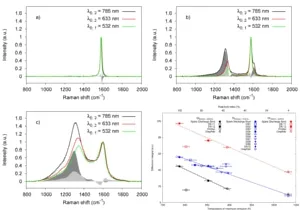Multiwavelength Raman Microspectroscopy for Rapid Prediction of Soot Oxidation Reactivity
Objectives
- Characterization of (bio)diesel soot structure
- Structure-reactivity relationship for different soot samples
- Prediction of soot reactivity by MWRM
Methods of Approach
- Diesel exhaust aftertreatment model system
- Multiwavelength Raman Microspectroscopy
Description
Based on the dispersive character of carbon D mode in Raman spectra (i.e. red shift and increase in intensity at higher excitation wavelength), we are developing the Multiwavelength Raman microspectroscopy (MWRM) for rapid soot reactivity prediction. In this approach we investigate various (bio)diesel soot samples and related carbonaceous materials at different excitation wavelengthes (785, 633, 532, and 514 nm). MWRM analysis can highlight substantial differences in the structural ordering of soot samples and carbonaceous materials.
To obtain the relation between structure and reactivity of soot, MWRM analysis can be combined with temperature-programmed oxidation (TPO). TPO allows us to characterize the oxidation behaviour of soot in terms of the maximum emission (CO + CO2) temperature and reactivity index. The latter is calculated by introducing the reactivity limits: spark discharge soot containing a large amount of disorder represents the upper limit, whereas the lower limit is given by graphite powder with high structural order. The comparison of MWRM (viz., the observed Raman difference integrals) and TPO data reveals a linear correlation between soot structure and oxidation reactivity which enables reactivity prediction by measuring the structure with MWRM.

Pubilcations
J. Schmid, B. Grob, R. Niessner & N. P. Ivleva, Multiwavelength Raman Microspectroscopy for Rapid Prediction of Soot Reactivity, Analytical Chemistry, 83, 1173, (2011)
M. Knauer, M. E. Schuster, D. Su, R. Schlögl, R. Niessner & N. P. Ivleva, Soot Structure and Reactivity Analysis by Raman Microspectroscopy, Temperature Programmed Oxidation and High Resolution Transmission Electron Microscopy, The Journal of Physical Chemistry A, 113, 13871, (2009)